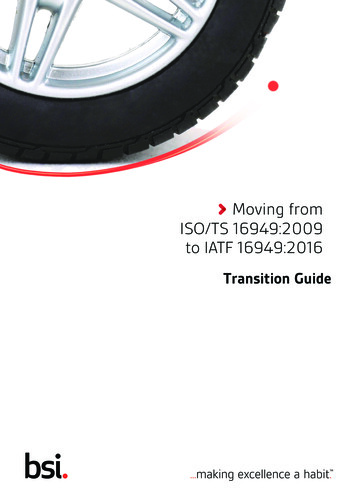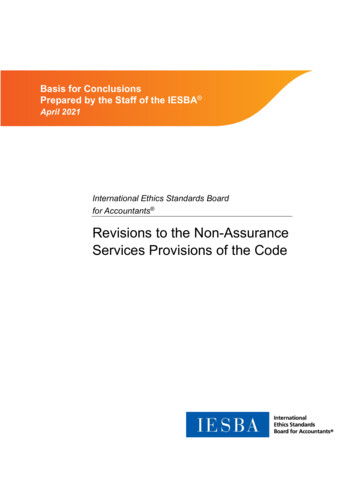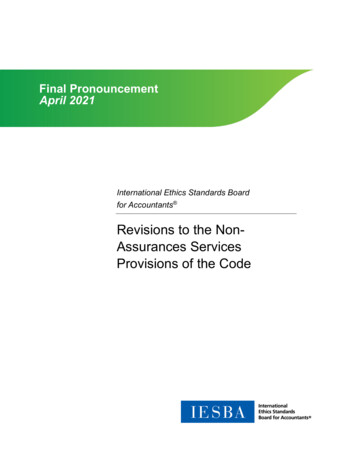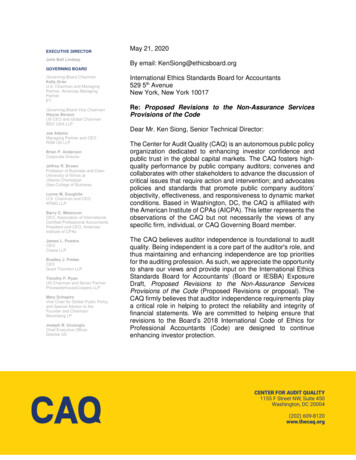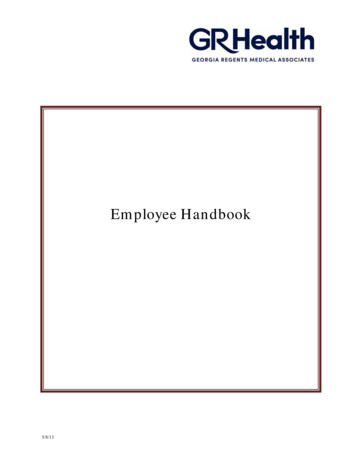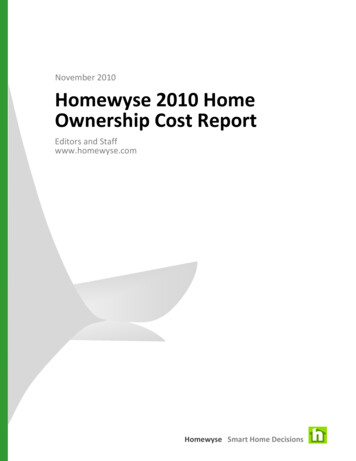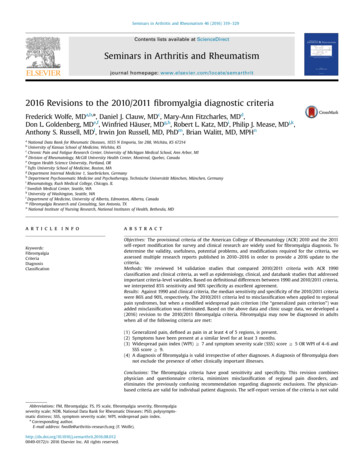
Transcription
Seminars in Arthritis and Rheumatism 46 (2016) 319–329Contents lists available at ScienceDirectSeminars in Arthritis and Rheumatismjournal homepage: www.elsevier.com/locate/semarthrit2016 Revisions to the 2010/2011 fibromyalgia diagnostic criteriaFrederick Wolfe, MDa,b,n, Daniel J. Clauw, MDc, Mary-Ann Fitzcharles, MDd,Don L. Goldenberg, MDe,f, Winfried Häuser, MDg,h, Robert L. Katz, MDi, Philip J. Mease, MDj,k,Anthony S. Russell, MDl, Irwin Jon Russell, MD, PhDm, Brian Walitt, MD, MPHnaNational Data Bank for Rheumatic Diseases, 1035 N Emporia, Ste 288, Wichita, KS 67214University of Kansas School of Medicine, Wichita, KScChronic Pain and Fatigue Research Center, University of Michigan Medical School, Ann Arbor, MIdDivision of Rheumatology, McGill University Health Center, Montreal, Quebec, CanadaeOregon Health Science University, Portland, ORfTufts University School of Medicine, Boston, MAgDepartment Internal Medicine 1, Saarbrücken, GermanyhDepartment Psychosomatic Medicine and Psychotherapy, Technische Universität München, München, GermanyiRheumatology, Rush Medical College, Chicago, ILjSwedish Medical Center, Seattle, WAkUniversity of Washington, Seattle, WAlDepartment of Medicine, University of Alberta, Edmonton, Alberta, CanadamFibromyalgia Research and Consulting, San Antonio, TXnNational Institute of Nursing Research, National Institutes of Health, Bethesda, MDba r t i c l e in ationa b s t r a c tObjectives: The provisional criteria of the American College of Rheumatology (ACR) 2010 and the 2011self-report modification for survey and clinical research are widely used for fibromyalgia diagnosis. Todetermine the validity, usefulness, potential problems, and modifications required for the criteria, weassessed multiple research reports published in 2010–2016 in order to provide a 2016 update to thecriteria.Methods: We reviewed 14 validation studies that compared 2010/2011 criteria with ACR 1990classification and clinical criteria, as well as epidemiology, clinical, and databank studies that addressedimportant criteria-level variables. Based on definitional differences between 1990 and 2010/2011 criteria,we interpreted 85% sensitivity and 90% specificity as excellent agreement.Results: Against 1990 and clinical criteria, the median sensitivity and specificity of the 2010/2011 criteriawere 86% and 90%, respectively. The 2010/2011 criteria led to misclassification when applied to regionalpain syndromes, but when a modified widespread pain criterion (the “generalized pain criterion”) wasadded misclassification was eliminated. Based on the above data and clinic usage data, we developed a(2016) revision to the 2010/2011 fibromyalgia criteria. Fibromyalgia may now be diagnosed in adultswhen all of the following criteria are met:(1) Generalized pain, defined as pain in at least 4 of 5 regions, is present.(2) Symptoms have been present at a similar level for at least 3 months.(3) Widespread pain index (WPI) Z 7 and symptom severity scale (SSS) score Z 5 OR WPI of 4–6 andSSS score Z 9.(4) A diagnosis of fibromyalgia is valid irrespective of other diagnoses. A diagnosis of fibromyalgia doesnot exclude the presence of other clinically important illnesses.Conclusions: The fibromyalgia criteria have good sensitivity and specificity. This revision combinesphysician and questionnaire criteria, minimizes misclassification of regional pain disorders, andeliminates the previously confusing recommendation regarding diagnostic exclusions. The physicianbased criteria are valid for individual patient diagnosis. The self-report version of the criteria is not validAbbreviations: FM, fibromyalgia; FS, FS scale, fibromyalgia severity, fibromyalgiaseverity scale; NDB, National Data Bank for Rheumatic Diseases; PSD, polysymptomatic distress; SSS, symptom severity scale; WPI, widespread pain index.nCorresponding author.E-mail address: fwolfe@arthritis-research.org (F. .08.0120049-0172/& 2016 Elsevier Inc. All rights reserved.
320F. Wolfe et al. / Seminars in Arthritis and Rheumatism 46 (2016) 319–329for clinical diagnosis in individual patients but is valid for research studies. These changes allow thecriteria to function as diagnostic criteria, while still being useful for classification.& 2016 Elsevier Inc. All rights reserved.IntroductionPurposeIn 1990, the American College of Rheumatology (ACR) firstapproved criteria for fibromyalgia, “The American College ofRheumatology 1990 criteria for the classification of fibromyalgia”[1]. In 2010, the ACR endorsed the “The American College ofRheumatology Preliminary Diagnostic Criteria for Fibromyalgiaand Measurement of Symptom Severity” as “an alternative methodof diagnosis” [2], but indicated that “This criteria set has beenapproved by the American College of Rheumatology (ACR) Boardof Directors as Provisional. This signifies that the criteria set hasbeen quantitatively validated using patient data, but it has notundergone validation based on an external data set. All ACRapproved criteria sets are expected to undergo intermittentupdates.” However, in 2015 the ACR altered its view of diagnosticcriteria, writing that “the ACR will provide approval only forclassification criteria and will no longer consider funding orendorsement of diagnostic criteria” [3]. Since the publication ofthe 2010/2011 criteria, multiple studies have been performed withrespect to validation. In addition, extensive research and clinicaluse of the criteria have identified areas for update. In this articlewe review validation and clinical data, combine the 2010/2011criteria into a single set, provide clarifying modifications to thecriteria, and describe how the new (2016) combined criteriashould be used. In these respects we follow the original 2010recommendations of the ACR for intermittent updates.BackgroundA detailed description of the history of fibromyalgia criteria isavailable [4]. Modern criteria for fibromyalgia arose in 1977 fromthe observations and criteria of Smythe and Moldofsky [5]. Theseauthors first proposed a tender point count and a requirement of“widespread aching.” In 1981, Yunus et al. [6] formally proposedcriteria that included tender points and the “presence of generalized aches and pains involving 3 or more anatomic sites .” In aneffort to standardize fibromyalgia criteria, a multi-center studywas organized that resulted in the ACR 1990 classification criteriafor fibromyalgia [1]. The criteria fixed the number of tender pointsat 11 out of a possible 18 and added the requirement for widespread pain—defined as 4-quadrant plus axial pain. The widespread pain criterion was not an essential part of the criteria, asthe criteria worked just as well in terms of accuracy without thewidespread pain requirement [1]. Defined widespread pain was anad hoc measure added only to aid in epidemiologic screening.However, with the passage of time, the widespread pain definitionbecame an essential element and central part of the fibromyalgiadefinition, even though it was not part of pre-1990 criteriadefinitions.There is no gold standard for fibromyalgia diagnosis. The 1990criteria were based on the consensus of unblinded rheumatologyphysician investigators in the 1990 study regarding the degree ofsymptom severity and how many tender points were needed todiagnose fibromyalgia. The 1990 criteria were widely accepted bythe research community, but generally ignored by most physiciansfor reasons that included the difficulty non-rheumatologists had inperforming the tender point examination. Although there are fewdata on this point, it is likely that most diagnoses in thecommunity were made by physicians who used symptoms ratherthan the tender point examination and the absolute widespreadpain requirement. Using 2012 US National Health Interview Survey(NHIS) data [7], Walitt et al. [8] have recently reported that more70% of persons reporting a diagnosis of fibromyalgia do not satisfyNHIS (surrogate) fibromyalgia criteria.Partly in response to the tender point difficulty, the 2010criteria dropped the tender point and widespread pain requirements, replacing them with a count of 19 painful regions and aseries of fibromyalgia symptom assessments. These changesaltered the case definition of fibromyalgia somewhat. Practically,the 2010 criteria study found that there was Z 85% agreement indiagnosis when using the 1990 and 2010 criteria set definitions,and that 93–94% of 2010 positive individuals satisfied the 1990widespread pain criterion—a level the 2010 authors consideredsatisfactory [2].The 1990 classification and 2010 diagnostic criteria weredeveloped among rheumatology patients and were physicianbased, meaning that the physician evaluated the patient by interview and used usual medical examinations to consider otherdiagnostic possibilities. The 1990 criteria assessment also requiredthe physician to perform a tender point examination. The 2010criteria required no specific physical examination. Instead, itdepended on the number of reported painful body regions, asassessed by the widespread pain index (WPI), and the severity ofsymptoms, as measured by the symptom severity scale (SSS). In2011, the authors of the 2010 criteria published a modification ofthe 2010 criteria that allowed diagnosis to be accomplishedentirely by self-report. In recognition of the problems with selfreport diagnosis, the 2011 authors cautioned that the modifiedcriteria should be used only for research and not for clinicaldiagnosis. The 2011 criteria also introduced a fibromyalgia severity(FS) score—the sum of the WPI and SSS—which permitteda quantitative measurement of the severity of fibromyalgiasymptoms.1 This scale can also be used with the 2010 criteria asthe WPI and SSS are part of both criteria sets. In the text thatfollows we often refer to the “2010/2011” criteria when we want toaddress the 2010 as well as the 2011 criteria, as both sets areextremely similar.The nature of fibromyalgia criteriaBoth the 1990 and the 2010/2011 criteria separate cases andnon-cases based on severity. The 2010/2011 criteria discriminatebased on the levels of WPI and SSS, but can easily and appropriately be modeled by the 0–31 FS score. By criteria definition, it isimpossible to satisfy the 2010/2011 criteria with an FS score o 12.The overall accuracy of an FS classification using an FS cut point of12–13 depends on the distribution of FS scores, but has beenshown to be about 92–96% (see discussion below and Ref. [9]). The1990 criteria require the presence of widespread pain (4-quadrantpain), but once that is present, all persons with Z11 tender pointssatisfy the fibromyalgia criteria. Approximately 10–12% of thegeneral population report widespread pain [10]. The tender pointcount depends not only on the intrinsic decrease in pain threshold1The name, FS score or scale, has also been called the polysymptomaticdistress scale (PSD), a term that has been vigorously contested and defendedelsewhere.
F. Wolfe et al. / Seminars in Arthritis and Rheumatism 46 (2016) 319–329321but also on the self-report of the patient and the performance andinterpretation of the physician examiner. The tender point count ishighly correlated with patient symptoms, but the dolorimetrymeasure of pain threshold, which may be considered a semiobjective measure of pain threshold, is not. Gracely et al. [11]called the tender point count “some unspecified combination oftenderness and distress”; it has also been called “a sedimentationrate for distress” [12].Measurement error and criteria assessmentThe absence of a gold standard to identify fibromyalgia confounds evaluation of fibromyalgia criteria. This problem beginswith the arbitrary nature of 1990 caseness and extends tomeasurement issues in the 1990 and 2010/2011 criteria. For the1990 criteria, measurement error, difficulty in the performance ofthe tender point examination, and subjective contribution ofphysicians and patients leads to reduced reliability and validity.However, except for concern about circularity expressed after thepublication of the 1990 criteria [13], there has been almost nocriticism of the validity or reliability of the 1990 criteria. The fewdata available show reliability coefficients r 0.71 [14–17]. Thetender point count appears to work best when there is unspokeninteraction between doctors and patients who take clues fromeach other and adjust their examinations and response, as fibromyalgia symptoms are always on the minds of the physician andpatient. One could argue that during the clinical interview for 1990criteria diagnosis, elements of the 2010/2011 criteria are almostalways included. However, no study has examined that possibility.In the evaluation of 2010/2011 criteria, the 1990 criteria havebeen used as a reference standard, with the result that inherentmeasurement error in the 1990 criteria will be carried over to the2010/2011 criteria. The idea that valid sensitivity and specificitycan be derived from comparisons with the 1990 criteria is onlypartially true, as the 1990 criteria examination will often beunreliable. A second major factor in any disagreement betweenthe 1990 and 2010/2011 criteria is that the 2010 criteria deliberately altered the definition of fibromyalgia slightly by explicitlygiving more emphasis to symptoms by the use of the SSS. Thus, inevaluating external data that includes the 1990 criteria, a level of85% agreement, as observed in the 2010 study [2], can beinterpreted as very close agreement.In accordance with ACR criteria committee’s recommendationin 2010 regarding external validation and intermittent updates, thepurpose of this report is to evaluate published data relating toexternal validation of the 2010/2011 criteria, examine publishedand unpublished problems with the criteria, and to update thecriteria to address problems that have been noted. In addition, wefurther propose to combine the 2010 and 2011 criteria sets andclarify definitions that would enable the combined 2016 revis
(4) A diagnosis of fibromyalgia is valid irrespective of other diagnoses. A diagnosis of fibromyalgia does not exclude the presence of other clinically important illnesses. Conclusions: The fibromyalgia criteria have good sensitivity and specificity. This revision combines
